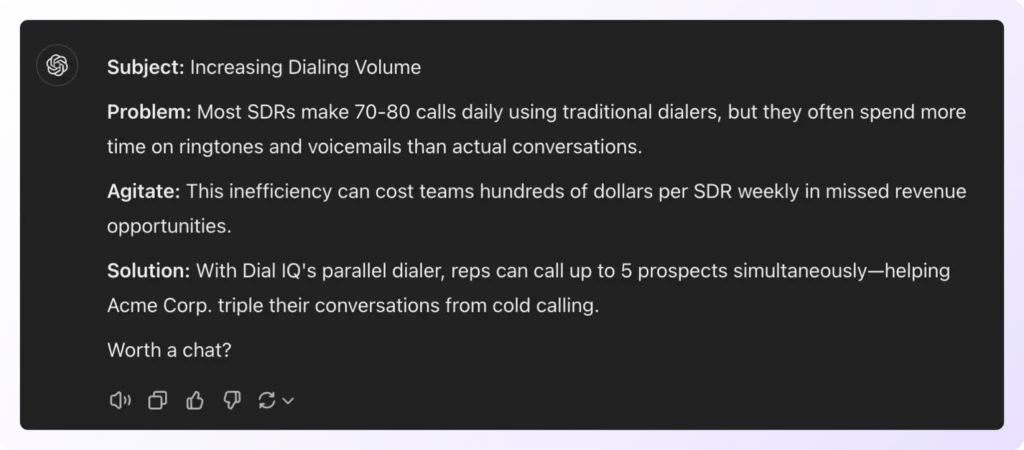Here’s the truth about cold emails: If all they do is shout, “Our company is amazing! Our product is revolutionary! We’re disrupting the industry!”—guess what? They’re probably just sitting in your prospect’s inbox, gathering digital cobwebs.
So, how do you craft a cold email that’s not a self-obsessed monologue but a story about your prospect? One that grabs attention, hits a nerve, and actually gets a response?
Use copywriting frameworks. They have been used for decades to turn bland messages into powerful narratives.
The PAS—Problem-Agitate-Solution is one of the most effective frameworks. Think of PAS as a three-act play where your prospect is the star, their pain point is the villain, and your solution is the hero they didn’t even know they needed.
But here’s the catch: Not everyone’s a natural storyteller.
Most sales reps aren’t sitting around with Don Draper’s knack for words. Writing a killer email takes time, skill, and the ability to use the right words and just the right tone.
This is where AI steps in.
Tools like ChatGPT can help sales reps take the heavy lifting out of email writing.
In this blog, we’ll explore the PAS framework, provide a ready-to-use ChatGPT prompt for creating cold emails, and share an example email generated using the framework.
What Makes PAS Work?
The brilliance of PAS lies in its understanding of how decisions are made. Rather than leading with features or credentials, it begins with what matters most to your prospect—their challenges.
PAS hinges on knowing your prospects and ensuring your message speaks directly to their needs. By highlighting the urgency of their situation, PAS prompts action and guides prospects toward the solution you offer.
1. Problem: The Art of Recognition
The first component focuses on identifying specific pain points that resonate. This isn't about vague statements - it's about demonstrating a deep understanding of your ICP’s challenges. The key is showing prospects you've done your homework and truly understand their situation.
2. Agitate: Expand the Impact
The agitation phase crystallizes the true cost of inaction. Here, you help prospects understand the ripple effects of their challenge - how it impacts revenue, team productivity, market position, or growth trajectory. The goal is to bring clarity to the full scope of the problem.
3. Solution: The Clear Path Forward
Having established the problem's significance, your solution becomes the logical next step. This section focuses on specific, measurable outcomes and demonstrates clear value. The key is connecting your solution directly to the established pain points and their broader business impact.
💡 ChatGPT Prompt: PAS FRAMEWORK
Write a PAS (Problem-Agitate-Solution) Style cold email to {{Fullname}} from {{Company}}.These are inputs about my company which I'm trying to sell:deal Customer: {ICP}
What does my product do? {Description}
The value we provide for the user: {Value Proposition}
What pain points do we solve? {Painpoints}
Competitor Advantage: {Competitor Advantage}
How we have helped people: {Case Study}
This is the input about the prospect: {Prospect_Research}Write the subject in the following format:Keep it simple, stating the main topic of the email. Avoid being overly creative or fancy. Limit it to 3-4 words max.Write the email in the following format:Problem: Begin with a personalized line highlighting a relevant pain point of {{Company}} that relates to our solution (using {Painpoints} and {Prospect_Research}).
Agitate: Dive deeper into the impact of this problem or why it’s challenging for companies like {{Company}} ({ICP} insights and competitor weaknesses can support this).Solution: Briefly introduce our solution with {Description}, {Value Proposition}, and any {Case Study} if applicable. Mention how we stand out ({Competitor Advantage} if applicable.).End with a CTA - Either “Worth a chat?” or “Worth exploring?”Guidelines:
Keep the email under 80 words.
Use a friendly, direct tone.
Make sure to bring forth all the mentioned elements of formatting.
Avoid vague terms like "streamline," "optimize," "maximize," etc.
Be as specific as possible without making assumptions about the prospect.
Sample Output:

Conclusion
The PAS framework and prompt provided are the blueprints for writing high-converting cold emails.
But the real challenge is scaling this for hundreds of prospects. Even with AI, executing this effectively at scale is a struggle.
That's why we built SDRx—an AI outbound agent that handles everything from in-depth prospect research to perfectly timed follow-ups, creating qualified pipeline without the manual grind.
By analyzing prospect behavior and leveraging 25 copywriting frameworks, SDRx generates highly personalized emails at scale, ensuring every outreach is relevant and impactful.
Want to use AI to create personalized, human-like emails for every prospect?
Book a demo of SDRx today.


